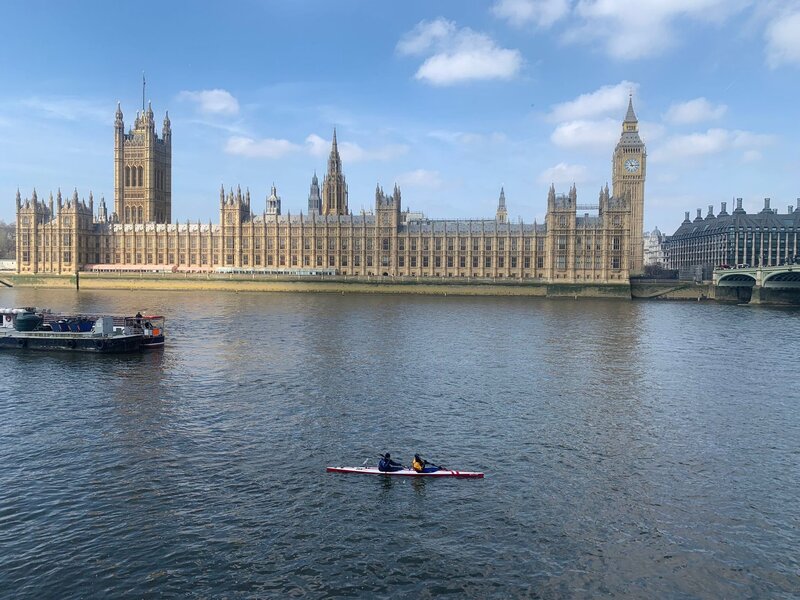
The ultra that finishes in front of parliament: England’s most brutal paddling race
“I can do anything now”
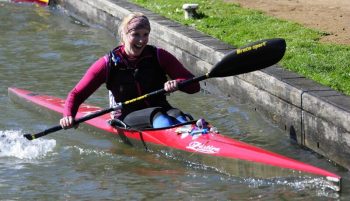
Kat Wilson slides into a portage in her K1 while completing DW a few years ago // photo: Fred Taylor via Facebook
That’s the feeling that Kat Wilson, 9-time finisher of the Devizes to Westminster race, said she had after completing her first DW at age 17. “When people throw you a challenge, whether it’s physical or mental, you remember that you did DW and came out stronger. That was a massive change for me.”
The Devizes to Westminster race, fondly called “DW”, has run almost every Easter weekend since 1948 making it one of the oldest continuous “ultras” in the world. Paddlers start in a tiny town in the West Country and race 125 miles on the Kennet & Avon Canal and the Thames River to reach the Houses of Parliament in central London. You can’t really say the race is known for its scenery, but finishing in front of Big Ben after 15-30 hours of racing through the night feels indescribably cool.
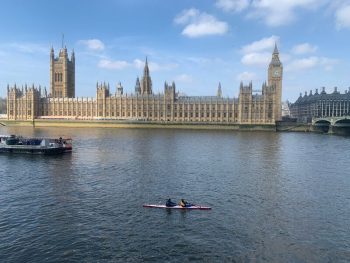
The Westminster finish of the Devizes to Westminster race // photo: DW Race
is this ultra really ‘fun’?
Ultra paddling can only be described as “fun” in the sense of “type 2 fun” (or type 3 when things go really sideways). But at least ultras like the Yukon and Alabama 650 boast stunning mountain and forest scenery along with a fast-flowing river current for the whole race. The first 52 miles of the Devizes to Westminster race is on a mostly dead flat canal with an average of more than one portage for every mile paddled. The whole race has 77 mandatory portages, almost all on the canal portion. In a year where the canal is low water, filled with debris, and busy with pleasure boaters on a warm Saturday afternoon (2023…), the first half of the race can mentally break paddlers before they even get to the river.
As racers get closer to London, the Kennet & Avon finally connects with the Thames River and their hard slog on the canal is usually rewarded with a strong downriver flow. At this point in the event, most racers are paddling in the dark. Because Easter is on the lunar calendar and the DW always coincides with Easter weekend, the racers get the benefit of a full moon – at least when it’s not covered behind clouds, a frequent occurrence in English weather (to the great disappointment of both paddlers and the entire country’s population). In the dark, paddlers pass below Windsor Castle lit up against the skyline.
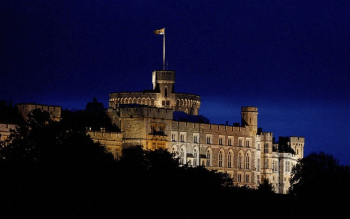
Racers paddle past Windsor Castle in the middle of the night // photo: Telegraph
DW is a time trial race, meaning that paddlers select their own start time based on how fast they expect to finish. 16 miles before the finish, the racers reach Teddington Lock where the Thames becomes tidal. Crews must reach this point within the “tide window” – several hours of the day where the flow of the tide will stay with them until they reach Westminster. Racers who don’t hit this tide window are not allowed to continue: trying to paddle against the flow at this stage of the race is just too risky.
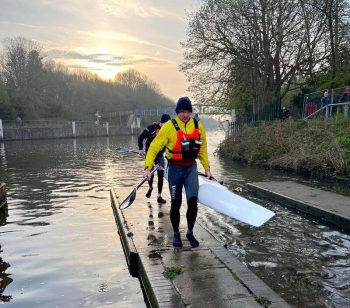
Billy and Dougal, one of last year’s top teams, portage onto the tidal Thames at Teddington at sunrise // photo: Billy Butler via Facebook
So if the racers have done a good job estimating their speed for the first 108 miles of the race, they’ll reach Teddington Lock around sunrise after paddling past Hampton Court Palace glowing in the early light of dawn (Hampton Court Palace is a a frequent Bridgerton filming location and former home of lots of British royalty). Teddington Lock is the last portage of the race (unless things go wrong downstream), and from this point on it’s mainly just a game of counting bridges and attempting to retain a semblance of sanity until Westminster Bridge. That said, many racers get all the way to this point and still fall short – just last year, the huge wake of an Uber commuter boat sent a canoe and kayak into bridge pylons and snapped the boats. Without a boat, neither crew got their finish. This year, the DW committee has plans to put race marshalls on the Uber boats to avoid a repeat of last year’s incident.
With all the usual physical and mental suffering that comes with completing an ultra, plus the brutally slow slog on the canal, absurd number of portages, and terrifying risks of paddling past giant commuter boats in Central London, why do people keep coming back to do DW again and again?
“DW Changed my life”
Kat Wilson (née Burbeck) is racing her 10th DW this year and will fervently preach about the Easter madness to anyone who will listen: “DW changed my life.” From her first race at age 17, she found a bunch of people who she “massively connected with.” When Kat went to university, she kept up her canoeing and made her best friends there. She even met her husband canoeing. Gareth Wilson was a DW sceptic until he met Kat. Why so many people would put themselves through this sheer misery again and again, year after year, was a mystery:
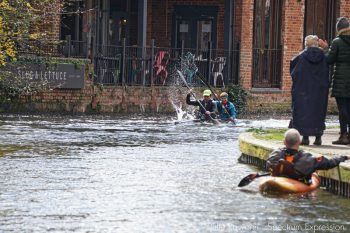
Kat Wilson finishing strong at one of the lead-up races to DW this year (photo: Julie Raworth, Spectrum Expressions)
“I’ve watched her train before work, after work, weekends, rain, shine, sleet and probably snow. What inspires somebody to do that? What is it about this race that means it fills every waking moment, every thought, eventually taking over your life (in a good way) as an amateur? Why do people offer to be part of her support crew year on year knowing the challenge they will endure despite not paddling the course themselves in support of Kat and her partner’s success?”
Yet Gareth continued to watch Kat complete the race again and again, and he continued to support her as she won the women’s class in 2016 and set a new course record for women’s doubles, and as they had children who quickly became Kat’s most vocal and enthusiastic supporters along the race course. Gareth recognises now that DW has changed his life too:
“Despite never racing the event, it inadvertently changed my life. I’ve lived through it vicariously, observing Kat’s preparations, cycled through the night and supported her to Westminster Bridge. On a deeper level, if Kat had never been put into a boat by her teacher, she’d never have fallen in love with the event, stayed in canoeing and we’d never have met on a Wednesday evening at Holme Pierrepont and eventually got married and had kids.”
Even the fastest, most experienced, best-prepared paddlers finish DW in tatters – hands covered in blisters, wobbly and shivering, mentally euphoric and in shock at the same time. Most will stand in front of the most iconic view of central London and question their choice to do the race while also thinking “this is awesome.” Kat described the feeling of finishing:
The last 20km is the worst part of the race… The river gets wider and wider, and you get smaller and smaller and realise your insignificance in this vast river… [It’s] wild to think you’re a tiny person who’s paddled all the way from this little town in the West Country and found yourself in Central London… The relief as you come around the bend and see the bridge lined with people cheering. A couple of times, I finished as Big Ben was chiming… It’s epic.
Pure “type 2 fun,” the feeling is addictive. As Gareth articulated: “Like many women after childbirth who vow never to endure the pain again and choose to try for another baby, many competitors vow to never sit in a boat again only to find themselves inexplicably signing up for the race the following Easter. Therein lies the rub, the challenge and the inexplicable mental obsession.”
will DW allow stand up paddleboarders entry next year?
Although DW does not currently allow stand-up paddleboards entry, there is an ongoing debate and this year’s low entry numbers could be the push the race needs. Doing 77 portages with a paddleboard would be extraordinarily challenging, but so is doing the race in any craft. SUP racers have been successful in other ultras with lots of portages like the Trent 100, so it may just be a matter of time…
SUP Racer will be livestreaming the entire Devizes to Westminster Senior Doubles race starting the morning of Easter Saturday and finishing Easter Sunday, UK time. You can find the livestream on SUP Racer’s YouTube channel (for those who watched our livestream of Last Paddler Standing, we’re very excited that this race is less than 48 hours!). It will also be available on the Facebook page of our sister site, Paddle Daily. Tune in on Saturday 30th March, and get to know some of the top boats we’ll be following via their introductions on Paddle Daily!
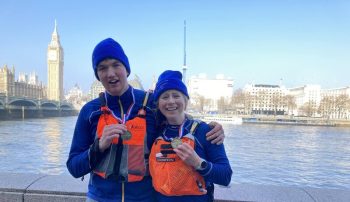
After winning the C2 (canoe) class at DW last year, James and Betsy will be providing commentary for this year’s DW Livestream. They hope to be feeling a little less… in shock when they reach Westminster with the camera and microphone this year.



